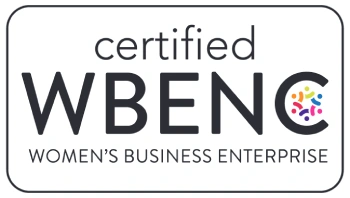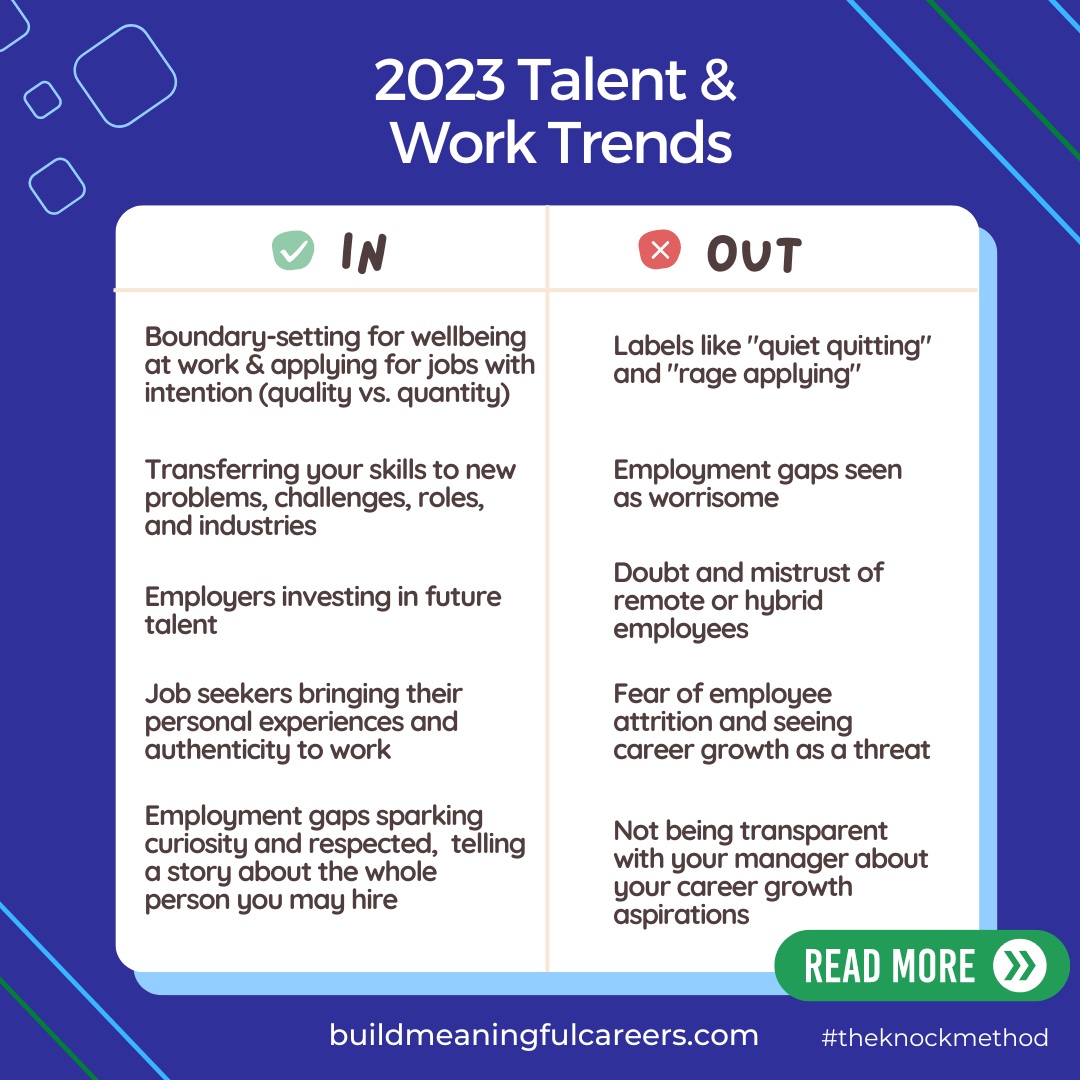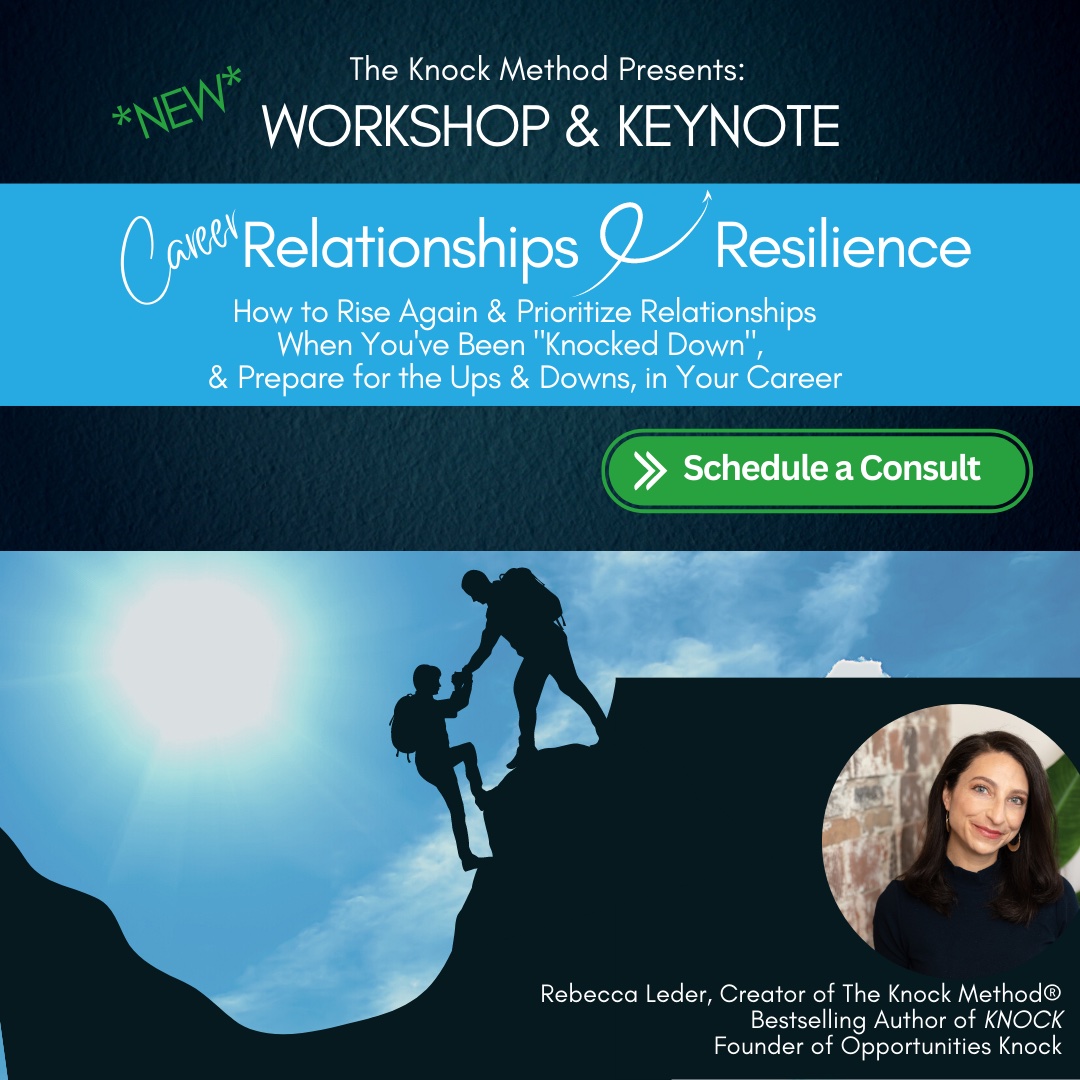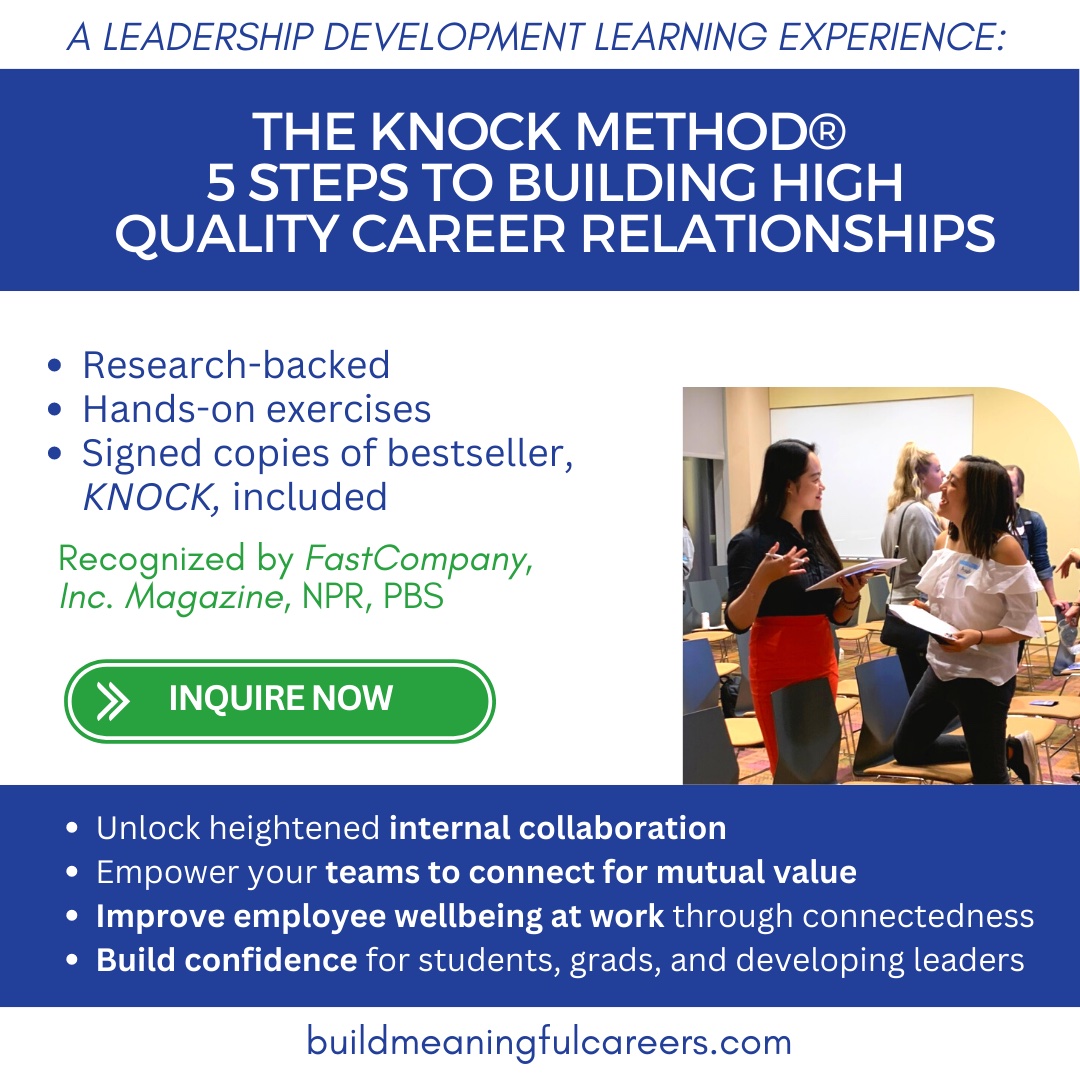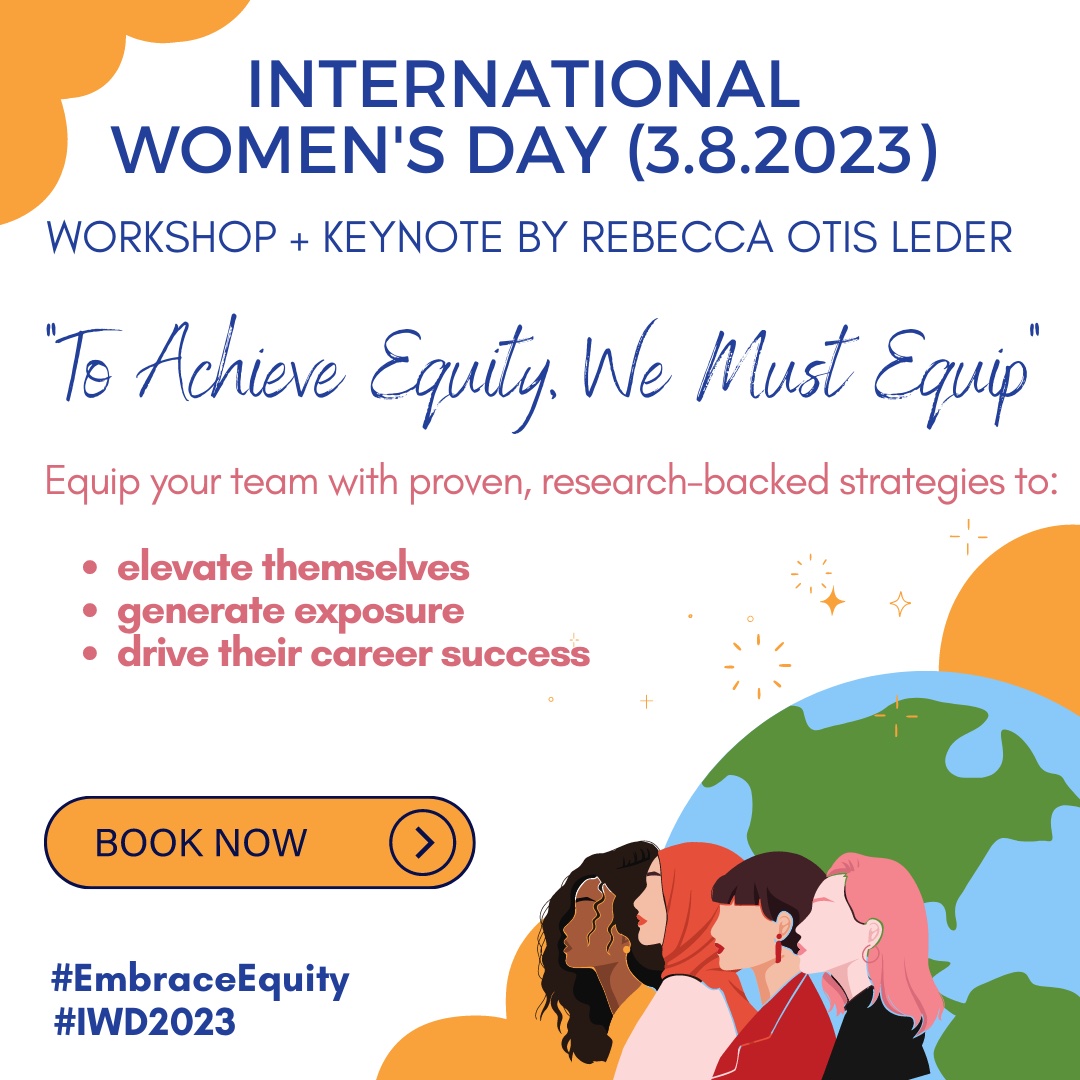There’s a post format going around Instagram since we’re at the start of a new year – a new take on new year’s resolutions: In/Out. These posts share what’s in, and what’s out for the coming year. Similarly, at recent conferences, in reviewing broad collections of industry publications, in conversations with clients, workshop participants, and attendees at my monthly KNOCK Neighborhood Night career conversations, I had been taking note of trends we should expect to see in 2023 related to talent, employment, and work. Here they are – what other trends are you seeing at the forefront of the employment marketplace?
1. Transferability of skills
When you learn a skill, whether in a personal, or professional context, such as project management, graphic design, writing, content strategy (organizing video, audio, or written content with a goal), or coding for example, you can transfer these skills across disciplines and contexts, from one role to a very different one, or even across industries. What if you learn web design in college, and you want to take it with you to design websites at a marketing agency in a full-time role? You can! (Check out the most valuable self-taught skill I’ve used in my career) What if your first internship is in customer service at a local retail chain, and you want to go into nursing where you take care of patients with the same approach to customer care? You can!
Telling that story of how your skills transfer and solve new problems can be the bridge from where you are, to where you want to be in your career.
And, there’s an entire domain dedicated to helping talent, prospective employees, and employers verify, document, and tell this story so that employers have proof of proficiency when it comes to these skills – it’s the credentials and microcredentials space (or perhaps you have heard of digital badges).
I attended a conference, The Badge Summit, solely focused on this topic: How might we help individuals gain skills, document the skills, verify their proficiency, and help them transfer them from educational institutions to employers, or from one employer to another, or from one employer to a university for professional development. In fact, there’s a company, SmartResume, that established a resume building platform where skills are verified (essentially an extra vote of confidence for employers) to confirm that what you say you know on your resume, you know, and what you say you did, you did.
Takeaway: If you’re worried you may not have the skills required for a different job, role, company, team, or industry, maybe you already have them! It’s simply about telling the story on your cover letter, resume, in interviews (and to yourself), about how those skills transfer to meet new goals.
2. Employers investing in future talent before they arrive
When I was at The Badge Summit, there was a huge contingency of attendees from higher education institutions. They often thought of employers as the “consumers” of credentials, or the benefactors of the skills already developed by incoming employees. However, I have led workshops, partnered with organizations, and been employed by companies who began investing in future talent before they became their employees – this is true more than ever now.
Workforce development organizations including Year Up, Generation USA, and The Hidden Genius Project, are partnering with companies to invest in future talent and grow with them through to full-time employment. Salesforce continues to focus on Trailhead, a skill-building platform that helps students and professionals earn badges and gain credentials to develop their careers – whether at the company or not. What better way to establish a strong, skilled pipeline of talent, than to invest in future employees and partner with them as they become part of your team.
Takeaway: Employers who are leading in the market are those who invest in their current employee career development and growth through education reimbursement, professional and leadership development training, AND future talent by creating a place they want to land, and growing with them even before they become employees.
Explore our professional, career, and leadership development workshops and learning experiences below:
- Career Relationships & Resilience
- The Knock Method®: 5 Steps to Building High Quality Career Relationships for Deeper Connection & Collaboration at Work
- International Women’s Day (3.3.2023): To Achieve Equity, We Must Equip – Build the skills to equip your team to elevate themselves, generate exposure, and drive their career success.
3. Job seekers bringing their personal experiences to work more, employers embracing and hiring well-rounded talent to build diverse teams that celebrate individualism, culture, and unique interests
Diversity, Equity, and Inclusion efforts continue to be a focus for employers, which means individuals’ culture, hobbies, talents are welcomed and celebrated. Do you love cooking international cuisine? Perhaps you can teach a team-building cooking class during International Women’s Day! Are you a manager and a Mom? Perhaps you can bring your two roles together to create an Employee Resource Group where Moms who work at your company and managers/aspiring leaders come together to share ideas and connect. As a result, employees feel that they can bring what makes them unique to work, and its celebrated, rather than isolating, and that other team members and even customers can relate and feel more comfortable and confident being themselves too. This creates a culture of inclusion and connection. A culture of psychological safety, where individuals are held accountable and called out when respect and inclusion is lacking, is cultivated as employers invest in helping their employees and teams learn the skills to build more connection through inclusion workshops, for example, in our often divided world.
Takeaway: Job seekers should hold informational interviews with current employees to get a sense of the prospective employer’s culture, and share personal interests and how they relate to the role they’re applying for to get a sense of whether it is embraced and celebrated, or seen as counterproductive to the work. Employers should get a sense of employee interests and what they can bring to the company to build a diverse team that attracts unique talent, and a culture where individuals feel a sense of belonging, rather than isolation. As a result, their work output will be of higher quality, their wellbeing will be nurtured, and as a result, the organization and the people who work within it will be healthier too.
Through the delivery of The Knock Method workshops, and my career development book, KNOCK, I train employees and teams to build skills that cultivate connection at work. It’s based on the social psychology research and work of Dr. Jane Dutton, and Dr. Monica Worline, in their book, Awakening Compassion at Work, which demonstrates that workplaces with compassion boost employee wellbeing, employee retention, and business performance.
4. Employment gaps are more widely accepted/embraced
Coming out of the COVID-19 pandemic, and a wave of company layoffs means that career gaps are even more common than they have been. And, it’s not often not a reflection of the employee’s skills or an indication of how their performance will be when hired by an employer. Even Linkedin (which many consider a digital resume) added a “Career Break” option to add to your work experience timeline on profiles in early 2022.
Takeaway: Don’t get down on yourself for a career break. Perhaps you were taking care of your family and that demonstrates your ability to prioritize and take care of “your team”. Perhaps a company’s financial performance declined due to market and economic instability. Your ability to move forward with resilience and manage change in your own life means you are flexible and can adjust to shifting priorities and goals with a future employer. Tell a story about your career break to help your employer get to know more about you if you can translate it into skills and how that break helped lead you to this new opportunity. Perhaps you took a sabbatical and cleared your head to get focused on the company and role you decided to pursue, showing your commitment and drive and that you’re ready for a new challenge.
5. Companies are retaining and attracting employees and taking care of their people with creative benefits
To adjust to the post-pandemic world where individuals were working more remotely and still uneasy about gathering with many people to protect their and their family’s health, a well-known tech company offered customers and employees a customer appreciation dinner, where they could also get takeout dinners to bring meals home to share with their families. It saved customers and employees the time and expense of coming up with dinner for a night which was a big help – one less thing to worry about! Another company I read about offered 2 weeks paid for employees for their first two weeks of work, so they’d start on Day 1 (really Day 14) rested and refreshed, plus they felt valued and invested in from the start.
Takeaway: Companies are becoming more human-centric, and focusing on employee wellbeing, which leads to employee retention, career fulfillment, and yes, of course performance. Prospective employees should explore the benefits their prospective employer is offering and investing in to get a sense of their values and get a sense of how they take care of the people who work for them, rather than simply viewing them as “resources” and a means to a financial performance end.
6. Work from anywhere
This is still a huge trend! Employees are calling in from home when they’re visiting family, or taking extending family vacation to include some work days in a beautiful setting. Flexibility is key and as long as the work gets done, and it’s done well, the location shouldn’t matter and may even help productivity and wellbeing. Plus, working while traveling means employees can connect with colleagues in person that they wouldn’t meet behind their computer screens.
Takeaway: Decide what physical work arrangement is best for your mindset and your output, then seek opportunities that fit the bill. In interviews, ask the recruiter and hiring manager about how various team members have flexibility and what the work arrangement will be, and ask current employees how they navigate setting boundaries and what kind of flexibility to expect (is it the same as what’s advertised on the job description)? Organizations who can have remote and hybrid workers must invest in the right tools, technologies, training, and systems to support remote work, yet still foster collaboration and teamwork.
Looking for collaboration and connection training and workshops for your team? Let’s connect.
7. Work/life Balance is out, work/life integration is in
According to Forbes and Envoy’s Return to Workplace survey, 63% of employees value flexibility as the most valuable benefit. Companies who survey employees and leaders to determine what flexibility means to them, and work with them on a work arrangement and schedule that allows them to be most productive at work and at home – in other words, valuing each employee’s lifestyle and needs – will continue to attract and retain top talent.
Takeaway: There’s no perfect balance but there can be a healthy relationship with work that allows for you to prioritize your personal needs and your professional responsibilities. Employers are learning what their employees want in terms of flexibility and employees are working with their managers to accommodate personal and professional needs. Job seekers, ask about this in interviews and know what you need up front to ensure aligned expectations with your manager and team. Hiring managers and employers, know what you need in terms of goals, responsibilities, and set expectations up front, including communications plans if something unexpected pops up or there’s a need outside of agreed-upon processes and schedules, so your new team members can be prepared and make arrangements in their personal lives to ensure success at work.
8. Employees are setting boundaries at work
Call it “quiet quitting” (I don’t call it quitting), or call it “boundary-setting”, employees are feeling more empowered to identify their needs and meet them. Rather than feeling overworked and undervalued, they’re keeping in check overextending themselves at work to the detriment of their health and their personal needs, and work suffers too as a result. Setting boundaries (which hours you will respond within except for work emergencies, or making it home for dinner time every night) is becoming a focus. Communicate openly with your manager or employer to determine how you’ll meet your personal needs so you can show up best at work, and don’t be afraid to ask for help.
You might be asking, “what about the boundaries that employers need to put in place?” If you openly communicate with your team members and build trust, sharing work goals and priorities, have regular check-ins, and get to know each person on a human level and how they best perform, employees will show up and get the job done well and understand they have responsibilities at work. It’s not about time away from work, it’s about using time in the best way possible and optimizing your team based on the individuals within it.
Takeaway: As we’ve entered a hybrid and remote working landscape, some employers are concerned with how to set standard work hours, rather than a focus on deliverables. Consider: what are the boundaries that must be in place to ensure job success? Similarly, employees who are looking to grow at work benefit from career growth plans and clear milestones and expectations to move up a level. Without these clear expectations, employees may “opt-out” of optional work activities or lose motivation to go the extra mile.
9. Job crafting
The art of shaping your role to utilize your strengths and skillsets beyond what’s on the job description can help employees grow and feel fulfilled in their careers, plus contribute to the role, team, work, and company beyond the minimum expected. Employees who get to use the skills they like to put to work feel more fulfilled and whole, leading to improved wellbeing, employee happiness and retention, and great work output! According to the research of Dr. Jane Dutton, Justin M. Berg, and Amy Wrzesniewski at the Center for Positive Organizations at the University of Michigan Ross School of Business, job crafting can generate positive outcomes when employees who job craft feel more fulfillment and meaning out of their work, and build resilience including personal growth and ability to cope with future adversity.
Takeaway: Employers can focus on employee retention by supporting individual career growth and helping employees by providing career development learning opportunities like training and workshops that build leadership and career communications skills, and finding “stretch projects” where employees get to practice new skills and learn in a new team environment or on creative projects outside of their typical day-to-day. Rather than feeling like they have to leave the company to do the kind of work they want to do, employees can consider pitching new responsibilities to their leaders to shift or add to their job description to help them put more of their talents and skill set to use, especially those that excite them! If you like the company that you work for and believe in the work, perhaps you can bring some of your special talents (even if they come from hobbies or personal pursuits) to the role and team to make an even bigger impact!
10. Career growth transparency
It used to be that if you had career aspirations beyond your current role, you’d keep them to yourself. If you have a manager or leader who cares about you and is committed to your success (wherever and however it is), sharing it with them can help them help you to reach your career goals. The trust and transparency that comes with sharing your career aspirations with your manager leads to psychological safety (you won’t worry that your job will go away) and you could gain the support you need to get to the next level or step as you build your meaningful career. Relationship-based Career coaching or mentoring can help you figure out the best way to communicate your career aspirations with your leadership so that they know you’re committed to doing your best work now, with a vision for the future. Reach out if you’d like to schedule a career coaching consult to see if it’s right for you.
Takeaway: Employees and managers can learn to build trust by having open conversations about career aspirations. Managers can plan for the future by understanding what kind of work would make their team members happy and fulfilled, and employees can explore whether there’s alignment with team and company goals. By having open conversations and expressing career goals and desires, no matter how vulnerable it feels, new opportunities may arise and you could gain a sponsor who can help you get there. For employers who feel threatened by employees having their sights set elsewhere, building trust is most important with your team members, and even if they do decide to work elsewhere, having your support could mean they refer amazing future talent to your team. For employees who don’t feel that have a relationship with their manager where they could openly share their career desires, consider whether you feel supported in your role the way you’d like to, and if the company culture is a fit for you.
For Employees & Job Seekers
Would you like support as you job search or build your meaningful career to make the most of these trends?
I’d like to help you along your career journey as a career coach, resume or cover letter editor, or mentor. submit a coaching request form, grab a copy of my career development bestseller, KNOCK: How to Open Doors and Build Career Relationships that Matter, download free career resources, or schedule a call and let’s see how we can help you move towards a fulfilling, meaningful career.
For Companies, Teams, Nonprofits, Careers Services, and Employers
Are you looking for a partner to help you build strategic learning programs to help your talent pipeline and current employees upskill and find fulfillment at work leading to improved customer relationships, customer success outcomes, employee wellbeing, and retention?
If you’re looking to help your teams move forward with resilience after a restructuring, or to help them build the skills to handle any career challenge that comes their way, schedule a consult and let’s chat about a career, talent, or leadership development workshop that fits your needs, such as my workshop on Building High Quality Career Relationships to foster more connection and collaboration at work, or my team building and employee leadership workshop: Build Career Relationships and Resilience.

